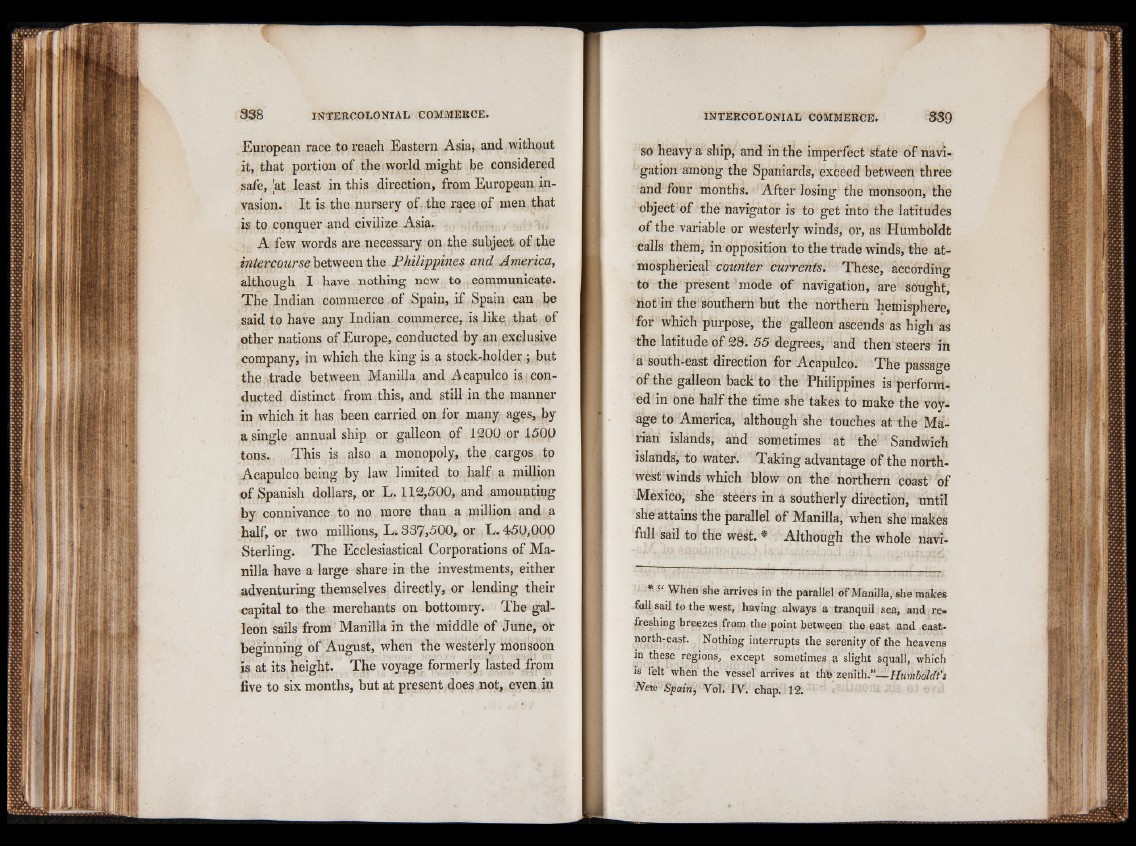
European race to reach Eastern Asia, and without
it, that portion of the world might be considered
safe, ’at least in this direction, from European invasion.
It is the. nursery of the race of men that
is to conquer and civilize Asia.
A few words are necessary on the Subject of the
intercourse between the Philippines and America,
although I have nothing new to communicate.
The Indian commerce of Spain, if Spain can be
said to have any Indian commerce, is like that of
other nations of Europe, conducted by an exclusive
company, in which the king is a stock-holder; but
the, trade between Manilla and Acapulco is conducted
distinct from this, and still in the manner
in which it has been carried on for many ages, by
a single annual ship or galleon of 1200 or 1500
tons. This is also a monopoly, the cargos to
Acapulco being by law limited to half a million
of Spanish dollars, or L. 112,500, and amounting
by connivance to no more than a million and a
half, or two millions, L. 337,500,. or E. 450,000
Sterling. The Ecclesiastical Corporations of Manilla
have a large share in the investments, either
adventuring themselves directly, or lending their
capital to the merchants on bottomry. The galleon
sails from Manilla in the middle of June, or
beginning of August, when the westerly monsoon
is at its height. The voyage formerly lasted from
five to six months, but at present does not, even in
so heavy a ship, and in the imperfect state of navigation
among the Spaniards, exceed between three
and four months. 11 After losing the monsoon, the
object of the navigator is to get into the latitudes
of the variable or westerly winds, or, as Humboldt
calls them, in opposition to the trade winds, the atmospherical
counter currents. These, according
to the present mode of navigation, are sought,
not in the southern but the northern hemisphere,
for which purpose, the galleon ascends as high as
the latitude of 28. 55 degrees, and then steers in
a south-east direction for Acapulco. The passage
of the galleon back to the Philippines is performed
in one half the time she takes to make the voyage
to America, although she touches at the Marian
islands, and sometimes at the’ Sandwich
islands, to water. Taking advantage of the northwest
winds which blow on the northern coast of
Mexico, she steers in a southerly direction, until
she attains the parallel of Manilla, when she makes
full sail to the west. * Although the whole navi*
“ When she arrives in the parallel of Manilla, she makes
full sail to the west, having always a tranquil sea, and re-,
freshing breezes,from the point between the east and east-
north-east. Nothing interrupts the serenity of the heavens
in these regions, except sometimes a slight squall, which
is felt when the vessel arrives at thb zenith.”— Humboldt's
Neii' Spain, Vol. IV. chap. 12.